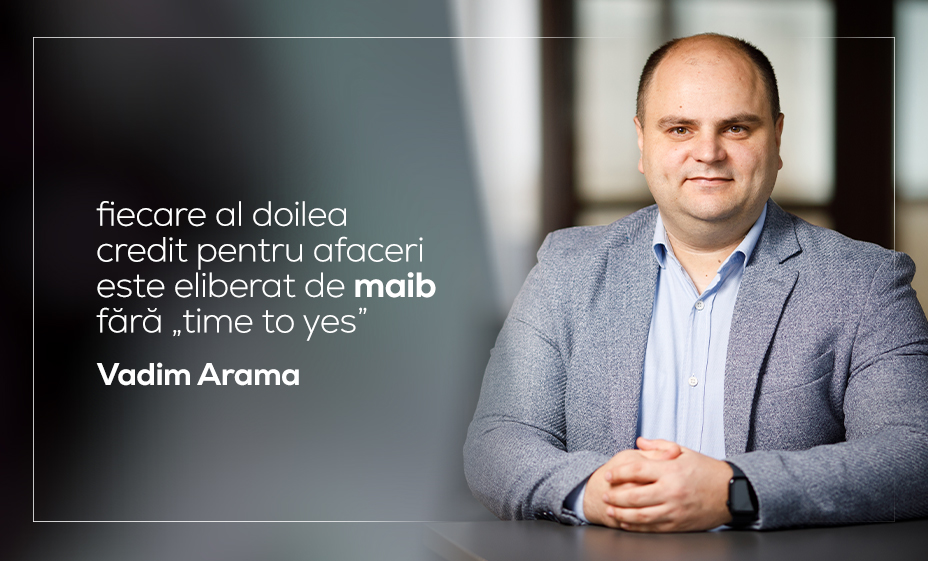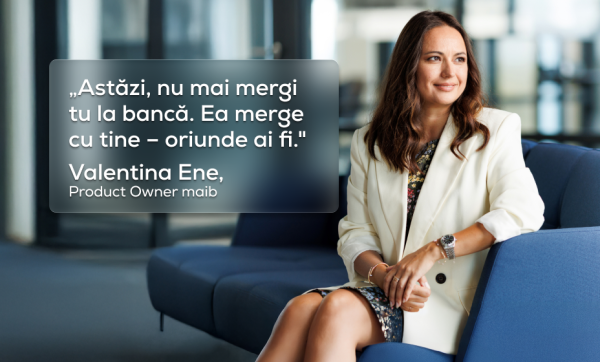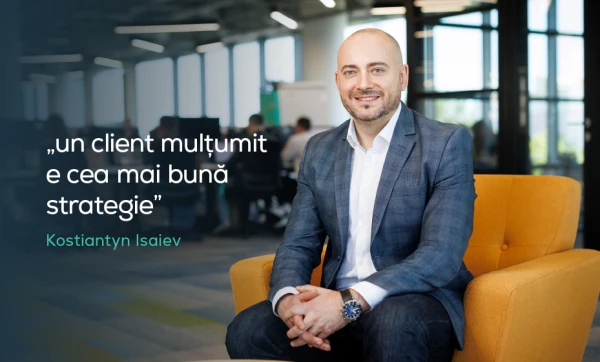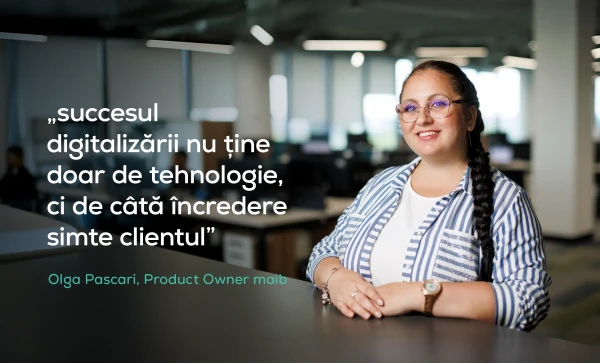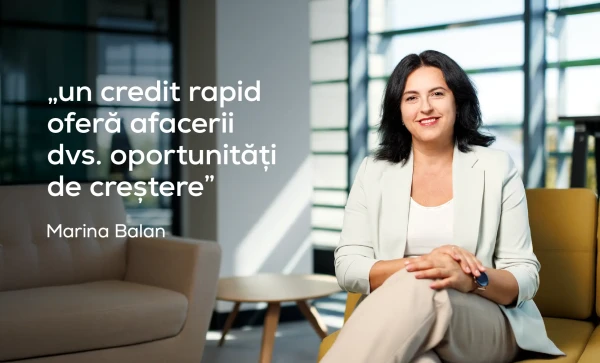Vadim Arama, the product owner of the "Time to Yes" band at maib, was interviewed by journalist Pavel Zingan, talking about business lending and the speed that characterises maib business.
Hello, Vadim. The first question doesn't even need to be formulated. What does "Time to Yes" actually mean?
It is the time frame in which the bank processes loan applications. This is a crucial factor for the customer - how long after submitting the application he can get the loan approved.
To clarify for readers, we are talking about business loans, i.e. for legal entities.
And individuals carrying out entrepreneurial activity.We have taken the difference into account. Whether we are talking about legal entities or individual entrepreneurs, the discussion is focused on loans intended for the business segment. To what extent do we cover the online or offline lending segment?
We are responsible for all application assessment processes, whether submitted online or offline. Our mission is to optimise this process and to do it quickly and accurately to serve the customer better.
You address the time factor, including correctly determining the likelihood of obtaining a loan by analysing customer information.
Much of the information already exists in the bank's system. We supplement it with data from all open sources, creating our own information set.
Let me specify. For example, if we take financial reports filed by businesses. This information is publicly available. That means you build a database in advance and don't wait for the specific customer to apply for a loan. Given that there are not millions of businesses in Moldova, this is a relatively small amount of data for modern computing capabilities.
In Moldova, about 60 thousand enterprises are reporting financial data. And we work precisely as you described. It is highly convenient for customers. When they apply for a loan, they don't have to spend time gathering and preparing this information, saving us the effort of looking for it.
And what information do you collect?
First, we refer to the financial reports that companies submit to statistical bodies. These are the balance sheet, cash flow, and profit and loss statements. Based on this data, an assessment is made using a specific algorithm, which determines the enterprise's creditworthiness and risks.
Is the algorithm developed in-house by the bank?
Yes, these are our internal developments. The reporting is available over an extended period, allowing us to assess the company's creditworthiness and, taking into account the dynamics of its development, to get a dynamic portrait. Assessing a company's rating based on a year or a few years is insufficient.
Do you look at anything else besides financial reporting?
Information about the company's shareholders and management. These are more at the level of reference information. However, the bank's internal information is a significant source of data for making lending decisions. Maib's market share constitutes more than 40% of companies in Moldova. Current account movements and group payments objectively represent a company's economic activity.
Do companies' credit histories also exist?
Here, we must distinguish between the legal possibilities of access to such histories. It is a different situation when a company has had a credit to maib because we hold the credit history. However, according to the law on credit bureaus, we can only request data if the company has applied to us for a credit or already has a credit with us. Therefore, for a preventive analysis of a company's creditworthiness, we cannot request the credit histories of businesses we do not serve.
So, the bank gathers information from open sources, adding information about the businesses it serves, and the Time to Yes team works to reduce the time it takes to process this information for loan applications.
Here, I would make a distinction between two components of this process. The first part is that, as a bank, we have this data and prepare a credit offer in advance. This is not yet a full loan approval, but it is the minimum amount that we are practically ready to offer immediately to the customer. In this case, the time to get the credit depends not so much on the Time to Yes but on the Time to Cash process - the time to grant the credit. Currently, about every second credit is granted in this way. Knowing the credit offer, the customer agrees to it, and the credit is granted in the shortest possible time.
As an individual, by accessing the maibank app, I see the bank's credit offers. But how do legal entities find out about the credit offer?
The bank's website, www.maib.md, has a section where legal entities enter their data and see the pre-approved credit offer. They can call 1314, Contact Center (legal entities) or go to a bank branch.
So you've eliminated the bureaucratic aspects these companies had to go through to apply for a loan, let alone get one. In figures, how many such offers have maib already prepared? How many businesses in the country, perhaps without even knowing it, have a calculated offer in their address and the possibility of obtaining a credit within it without any bureaucratic procedure?
We are talking about 25,000 companies. So, for them, "Time to Yes" has practically been transformed into "Time to Cash"?
Exactly.
What is the limit of this offer?
It depends on the customer category and essentially on the information we can collect autonomously about the customer within the legal limits. The categories comprise a combination of factors, whether the client provides financial reports and whether or not they are our client. In one case, there may be both financial reports and bank transaction history, and in another case - the lowest possible level of information. Obviously, for the formulation of a preliminary offer, this is a different basis for calculation. In each segment, we have our own ceiling for pre-approved offers.
What limits apply?
The maximum limit is up to 10 million MDL. It is when the company provides financial reports and is the maib customer. And up to 3 million MDL when it is not the bank's customer.
But 10 million MDL - isn't that a full loan without collateral?
Several other factors determine the proportion of loans granted with or without collateral.
And what about the limits of loans without collateral?
Maib customer - up to 2 million MDL.
If you have already developed the model to create pre-approved offers for customers and thus reduce the "Time to Yes" time, what is the team working on now?
We aim to improve the look and feel of the transition from credit offer to lending decision. Once the information is clarified, there can always be "pitfalls" that can increase the risk of granting credit, affecting the amount or even the granting itself.
The number of these unforeseen events can be reduced by increasing the frequency of information processing, making the process practically work online.
So, you want to switch from a credit offer to a pre-approved credit.
Yes, to reduce the customer's uncertainty factor, which will help them better plan their economic activity.
When do you plan to complete this process?
In the first half of 2024.
What important points have we left out of the discussion?
I want to convey to readers, especially entrepreneurs who have not applied for a loan in recent years, that the process of getting a loan from maib has changed radically. We have eliminated a large part of the bureaucratic procedures that created difficulties for the entrepreneur and their accounting. Now, the accountant does not have to fear the white hairs that used to appear in the process of preparing the package of documents for the loan. They are all within reach. The system of prepared credit offers radical changes in the roles of the client and bank. The bank becomes a real partner in the business because right from the start, the customer is informed about the available credit limit when planning the business.
Most decisions in the modern world have to be taken quickly. Knowing about loan availability, the customer will make a quicker decision, for example, to purchase many goods, enabling them to increase their turnover. And this is just one example. Credit must become a tool for growth and development. Our task is to minimise the bank's "Time to Yes" time. Here, we refer to maib customers and customers of other banks who approach maib for a loan.


 maibank
maibank
 maib business app
maib business app
 online loans – legal entities
online loans – legal entities
 internet banking - individuals
internet banking - individuals
 new internet banking - maib business
new internet banking - maib business
 internet Banking - BankFlex
internet Banking - BankFlex
